Broadband Bi-Directional All-Dielectric Transparent Metamaterial Absorber
Abstract
:1. Introduction
2. Materials and Methods
3. Results and Discussion
4. Experiment Verification
5. Conclusions
Author Contributions
Funding
Data Availability Statement
Conflicts of Interest
References
- Engheta, N. Thin Absorbing Screens Using Metamaterial Surfaces. In Proceedings of the IEEE Antennas and Propagation Society International Symposium, San Antonio, TX, USA, 16–21 June 2002; pp. 392–395. [Google Scholar]
- Landy, N.I.; Sajuyigbe, S.; Mock, J.J.; Smith, D.R.; Padilla, W.J. Perfect Metamaterial Absorber. Phys. Rev. Lett. 2008, 100, 207402. [Google Scholar] [CrossRef] [PubMed]
- Watts, C.M.; Liu, X.; Padilla, W.J. Metamaterial Electromagnetic Wave Absorbers. Adv. Opt. Mater. 2012, 24, OP98–OP120. [Google Scholar] [CrossRef]
- Zeng, X.; Cheng, X.; Yu, R.; Stucky, G.D. Electromagnetic Microwave Absorption Theory and Recent Achievements in Microwave Absorbers. Carbon 2020, 168, 606–623. [Google Scholar] [CrossRef]
- Zhao, G.; Bi, S.; Niu, M.; Cui, Y. A Zero Refraction Metamaterial and Its Application in Electromagnetic Stealth Cloak. Mater. Today Commun. 2019, 21, 100603. [Google Scholar] [CrossRef]
- Chen, H.; Ma, W.; Huang, Z.; Zhang, Y.; Huang, Y.; Chen, Y. Graphene-Based Materials toward Microwave and Terahertz Absorbing Stealth Technologies. Adv. Opt. Mater. 2019, 7, 1801318. [Google Scholar] [CrossRef]
- Zhang, Y.; Lin, P.; Lin, Y.S. Tunable Split-Disk Metamaterial Absorber for Sensing Application. Nanomaterials 2021, 11, 598. [Google Scholar] [CrossRef] [PubMed]
- Almoneef, T.S.; Erkmen, F.; Ramahi, O.M. Harvesting the Energy of Multi-Polarized Electromagnetic Waves. Sci. Rep. 2017, 7, 14656. [Google Scholar] [CrossRef] [Green Version]
- Tofigh, F.; Amiri, M.; Shariati, N.; Lipman, J.; Abolhasan, M. Polarization-Insensitive Metamaterial Absorber for Crowd Estimation Based on Electromagnetic Energy Measurements. IEEE Trans. Antennas Propag. 2020, 68, 1458–1467. [Google Scholar] [CrossRef]
- Amiri, M.; Tofigh, F.; Shariati, N.; Lipman, J.; Abolhasan, M. Review on Metamaterial Perfect Absorbers and Their Applications to IoT. IEEE Internet Things J. 2021, 8, 4105–4131. [Google Scholar] [CrossRef]
- Cai, H.; Sun, Y.; Wang, X.; Zhan, S. Design of an Ultra-Broadband near-Perfect Bilayer Grating Metamaterial Absorber Based on Genetic Algorithm. Opt. Express 2020, 28, 15347. [Google Scholar] [CrossRef] [PubMed]
- Ning, J.; Chen, K.; Zhao, W.; Zhao, J.; Jiang, T.; Feng, Y. An Ultrathin Tunable Metamaterial Absorber for Lower Microwave Band Based on Magnetic Nanomaterial. Nanomaterials 2022, 12, 2135. [Google Scholar] [CrossRef]
- Cen, C.; Chen, Z.; Xu, D.; Jiang, L.; Chen, X.; Yi, Z.; Wu, P.; Li, G.; Yi, Y. High Quality Factor, High Sensitivity Metamaterial Graphene—Perfect Absorber Based on Critical Coupling Theory and Impedance Matching. Nanomaterials 2020, 10, 95. [Google Scholar] [CrossRef] [PubMed] [Green Version]
- Zhang, F.; Wang, Q.; Zhou, T.; Xiong, Y.; Wen, Y.; Jiang, C.; Wang, Y.; Du, Z.; Abrahams, I.; Wang, L.Z.; et al. A Multi-Band Binary Radar Absorbing Metamaterial Based on a 3D Low-Permittivity All-Dielectric Structure. J. Alloys Compd. 2020, 814, 152300. [Google Scholar] [CrossRef]
- Tang, B.; Yang, N.; Song, X.; Jin, G.; Su, J. Triple-Band Anisotropic Perfect Absorbers Based on α-Phase MoO3 Metamaterials in Visible Frequencies. Nanomaterials 2021, 11, 2061. [Google Scholar] [CrossRef]
- Zhang, X.; Zhang, D.; Fu, Y.; Li, S.; Wei, Y.; Chen, K.; Wang, X.; Zhuang, S. 3-D Printed Swastika-Shaped Ultrabroadband Water-Based Microwave Absorber. IEEE Antennas Wirel. Propag. Lett. 2020, 19, 821–825. [Google Scholar] [CrossRef]
- Yu, P.; Besteiro, L.V.; Huang, Y.; Wu, J.; Fu, L.; Tan, H.H.; Jagadish, C.; Wiederrecht, G.P.; Govorov, A.O.; Wang, Z. Broadband Metamaterial Absorbers. Adv. Opt. Mater. 2019, 7, 1800995. [Google Scholar] [CrossRef] [Green Version]
- Han, X.; Wang, Y.; Xu, J.; Yu, H. An Ultrathin Wideband Microwave Metamaterial Absorber Based on Frequency Selective Surface. Adv. Electron. Mater. 2021, 8, 2101040. [Google Scholar] [CrossRef]
- Fan, S.; Song, Y. Ultra-Wideband Flexible Absorber in Microwave Frequency Band. Materials 2020, 13, 4883. [Google Scholar] [CrossRef]
- Chen, M.; Xiao, Z.; Cui, Z.; Xu, Q. Dynamically Switchable Dual-Band Absorber Based on Electromagnetically Induced Reflection in Metal-Graphene Hybrid Metamaterial. Opt. Commun. 2022, 502, 127423. [Google Scholar] [CrossRef]
- Badri, S.H.; Gilarlue, M.M.; Saeidnahaei, S.; Kim, J.S. Narrowband-to-Broadband Switchable and Polarization-Insensitive Terahertz Metasurface Absorber Enabled by Phase-Change Material. J. Opt. 2022, 24, 025101. [Google Scholar] [CrossRef]
- Ahmadivand, A.; Gerislioglu, B.; Ahuja, R.; Mishra, Y.K. Toroidal Metaphotonics and Metadevices. Laser Photonics Rev. 2020, 14, 50–52. [Google Scholar] [CrossRef]
- Feng, H.; Zhang, Z.; Zhang, J.; Fang, D.; Wang, J.; Liu, C.; Wu, T.; Wang, G.; Wang, L.; Ran, L.; et al. Tunable Dual-Broadband Terahertz Absorber with Vanadium Dioxide Metamaterial. Nanomaterials 2022, 12, 1731. [Google Scholar] [CrossRef] [PubMed]
- Cheng, Y.; Xiong, M.; Chen, M.; Deng, S.; Liu, H.; Teng, C.; Yang, H.; Deng, H.; Yuan, L. Numerical Study of Ultra-Broadband Metamaterial Perfect Absorber Based on Four-Corner Star Array. Nanomaterials 2021, 11, 2172. [Google Scholar] [CrossRef] [PubMed]
- Xiong, H.; Yang, F. Ultra-Broadband and Tunable Saline Water-Based Absorber in Microwave Regime. Opt. Express 2020, 28, 5306. [Google Scholar] [CrossRef]
- Zhang, J.; Wu, X.; Liu, L.; Huang, C.; Chen, X.; Tian, Z.; Ouyang, C.; Gu, J.; Zhang, X.; He, M.; et al. Ultra-Broadband Microwave Metamaterial Absorber with Tetramethylurea Inclusion. Opt. Express 2019, 27, 25595. [Google Scholar] [CrossRef] [PubMed]
- Yoo, Y.J.; Ju, S.; Park, S.Y.; Ju Kim, Y.; Bong, J.; Lim, T.; Kim, K.W.; Rhee, J.Y.; Lee, Y.P. Metamaterial Absorber for Electromagnetic Waves in Periodic Water Droplets. Sci. Rep. 2015, 5, 14018. [Google Scholar] [CrossRef] [PubMed] [Green Version]
- Zhu, W.; Rukhlenko, I.D.; Xiao, F.; He, C.; Geng, J.; Liang, X.; Premaratne, M.; Jin, R. Multiband Coherent Perfect Absorption in a Water-Based Metasurface. Opt. Express 2017, 25, 15737. [Google Scholar] [CrossRef] [PubMed]
- Yan, X.; Kong, X.; Wang, Q.; Xing, L.; Xue, F.; Xu, Y.; Jiang, S.; Liu, X. Water-Based Reconfigurable Frequency Selective Rasorber with Thermally Tunable Absorption Band. IEEE Trans. Antennas Propag. 2020, 68, 6162–6171. [Google Scholar] [CrossRef] [Green Version]
- Chen, Y.; Chen, K.; Zhang, D.; Li, S.; Xu, Y.; Wang, X.; Zhuang, S. Ultrabroadband Microwave Absorber Based on 3D Water Microchannels. Photonics Res. 2021, 9, 1391. [Google Scholar] [CrossRef]
- Wen, J.; Zhao, Q.; Peng, R.; Yao, H.; Qing, Y.; Yin, J.; Ren, Q. Progress in Water-Based Metamaterial Absorbers: A Review. Opt. Mater. Express 2022, 12, 1461–1479. [Google Scholar] [CrossRef]
- Jacobsen, R.E.; Arslanagić, S.; Lavrinenko, A.V. Water-Based Devices for Advanced Control of Electromagnetic Waves. Appl. Phys. Rev. 2021, 8, 041304. [Google Scholar] [CrossRef]
- Andryieuski, A.; Kuznetsova, S.M.; Zhukovsky, S.V.; Kivshar, Y.S.; Lavrinenko, A.V. Water: Promising Opportunities for Tunable All-Dielectric Electromagnetic Metamaterials. Sci. Rep. 2015, 5, 13535. [Google Scholar] [CrossRef] [Green Version]
- Huang, X.; Yang, H.; Shen, Z.; Chen, J.; Lin, H.; Yu, Z. Water-Injected All-Dielectric Ultra-Wideband and Prominent Oblique Incidence Metamaterial Absorber in Microwave Regime. J. Phys. D Appl. Phys. 2017, 50, 385304. [Google Scholar] [CrossRef]
- Rajabalipanah, H.; Abdolali, A.; Mohammadi, M. Experimental and Analytical Investigations on a Wide-Angle, Polarization-Insensitive, and Broadband Water-Based Metamaterial Absorber. J. Phys. D Appl. Phys. 2021, 54, 225302. [Google Scholar] [CrossRef]
- Song, Q.; Zhang, W.; Wu, P.C.; Zhu, W.; Shen, Z.X.; Chong, P.H.J.; Liang, Q.X.; Yang, Z.C.; Hao, Y.L.; Cai, H.; et al. Water-Resonator-Based Metasurface: An Ultrabroadband and Near-Unity Absorption. Adv. Opt. Mater. 2017, 5, 1601103. [Google Scholar] [CrossRef]
- Odit, M.; Kapitanova, P.; Andryieuski, A.; Belov, P.; Lavrinenko, A.V. Experimental Demonstration of Water Based Tunable Metasurface. Appl. Phys. Lett. 2016, 109, 011901. [Google Scholar] [CrossRef] [Green Version]
- Zhao, J.; Wei, S.; Wang, C.; Chen, K.; Zhu, B.; Jiang, T.; Feng, Y. Broadband Microwave Absorption Utilizing Water-Based Metamaterial Structures. Opt. Express 2018, 26, 8522–8531. [Google Scholar] [CrossRef]
- Shen, Y.; Zhang, J.; Pang, Y.; Wang, J.; Ma, H.; Qu, S. Transparent Broadband Metamaterial Absorber Enhanced by Water-Substrate Incorporation. Opt. Express 2018, 26, 15665. [Google Scholar] [CrossRef] [PubMed]
- Xie, J.; Quader, S.; Xiao, F.; He, C.; Liang, X.; Geng, J.; Jin, R.; Zhu, W.; Rukhlenko, I.D. Truly All-Dielectric Ultrabroadband Metamaterial Absorber: Water-Based and Ground-Free. IEEE Antennas Wirel. Propag. Lett. 2019, 18, 536–540. [Google Scholar] [CrossRef]
- Wang, Q.; Bi, K.; Lim, S. All-Dielectric Transparent Metamaterial Absorber with Encapsulated Water. IEEE Access 2020, 8, 175998–176004. [Google Scholar] [CrossRef]
- Lu, Y.; Chen, J.; Li, J. Design of All-Dielectric Ultra-Wideband Transparent Water-Based Absorber. J. Phys. D Appl. Phys. 2022, 55, 115502. [Google Scholar] [CrossRef]
- Xie, J.; Zhu, W.; Rukhlenko, I.D.; Xiao, F.; He, C.; Geng, J.; Liang, X.; Jin, R.; Premaratne, M. Water Metamaterial for Ultra-Broadband and Wide-Angle Absorption. Opt. Express 2018, 26, 5052. [Google Scholar] [CrossRef]
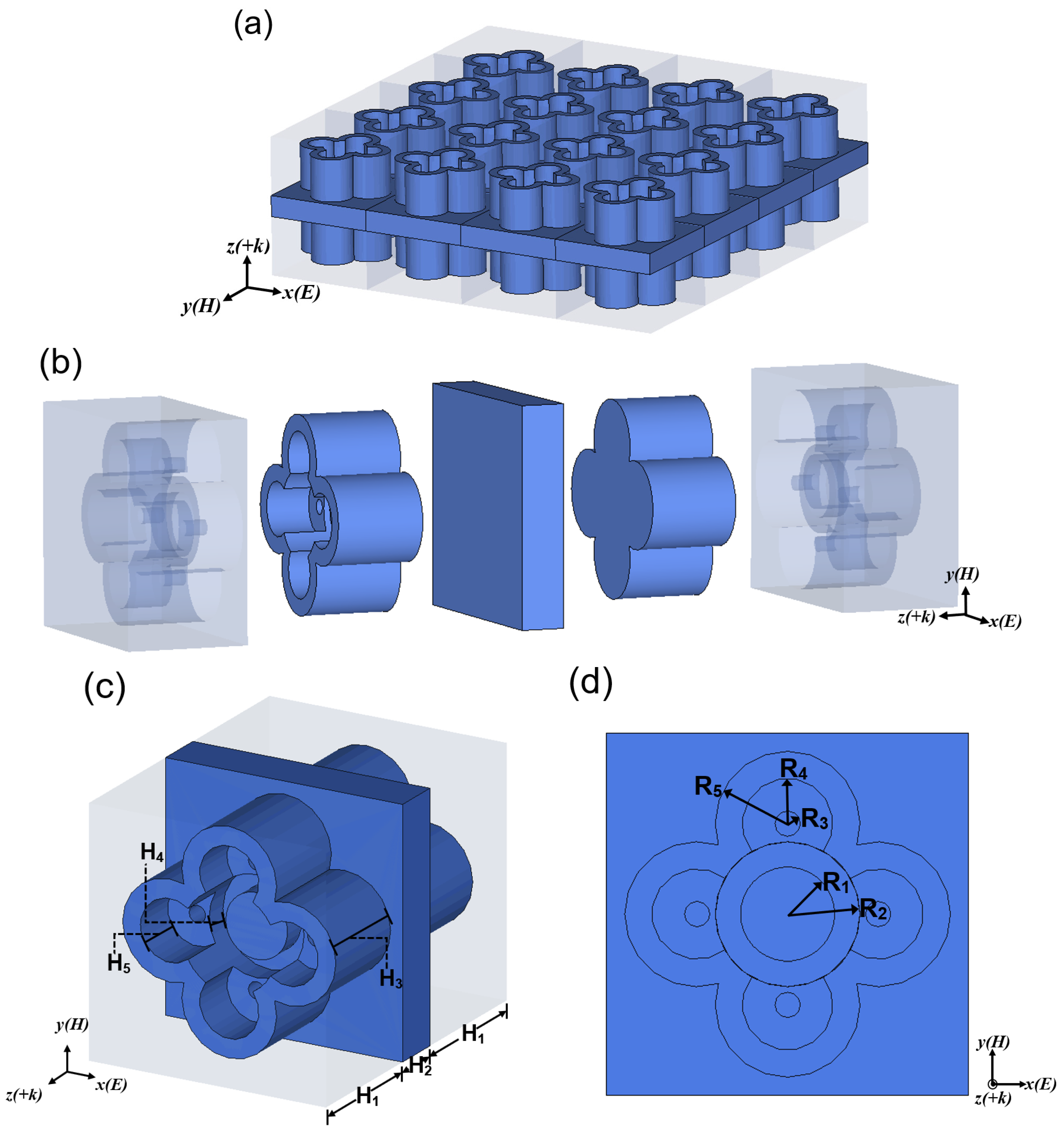
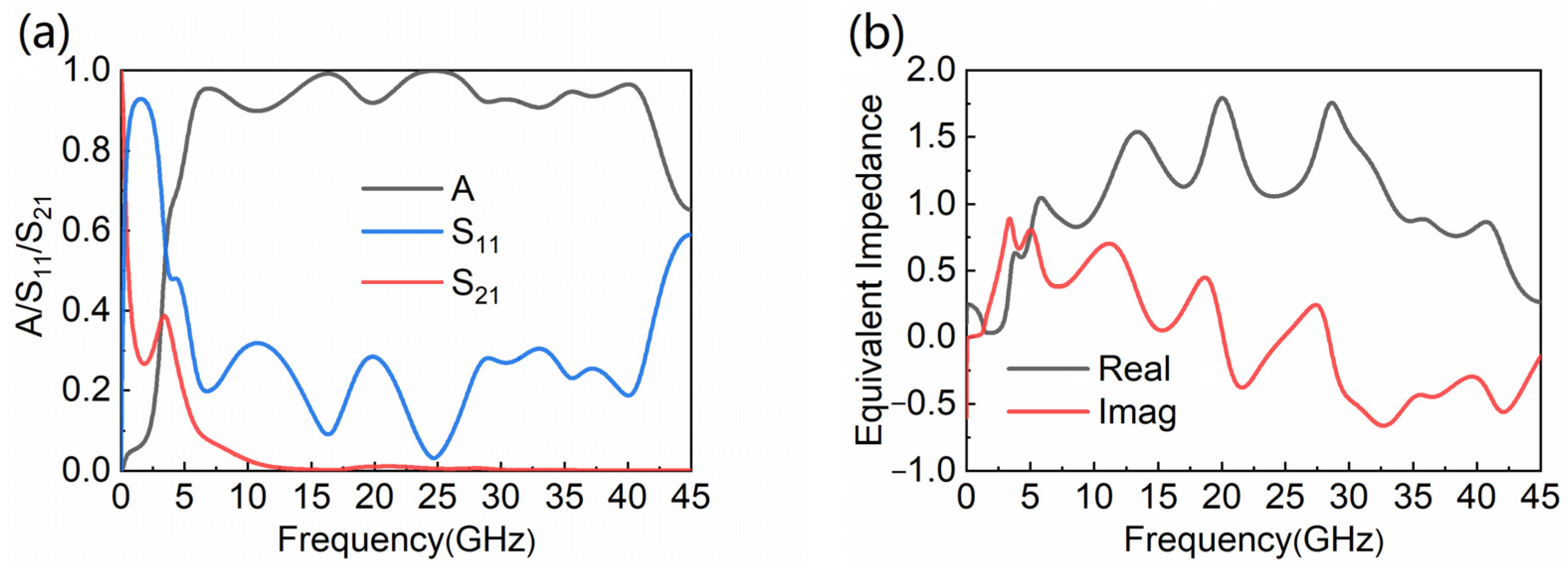
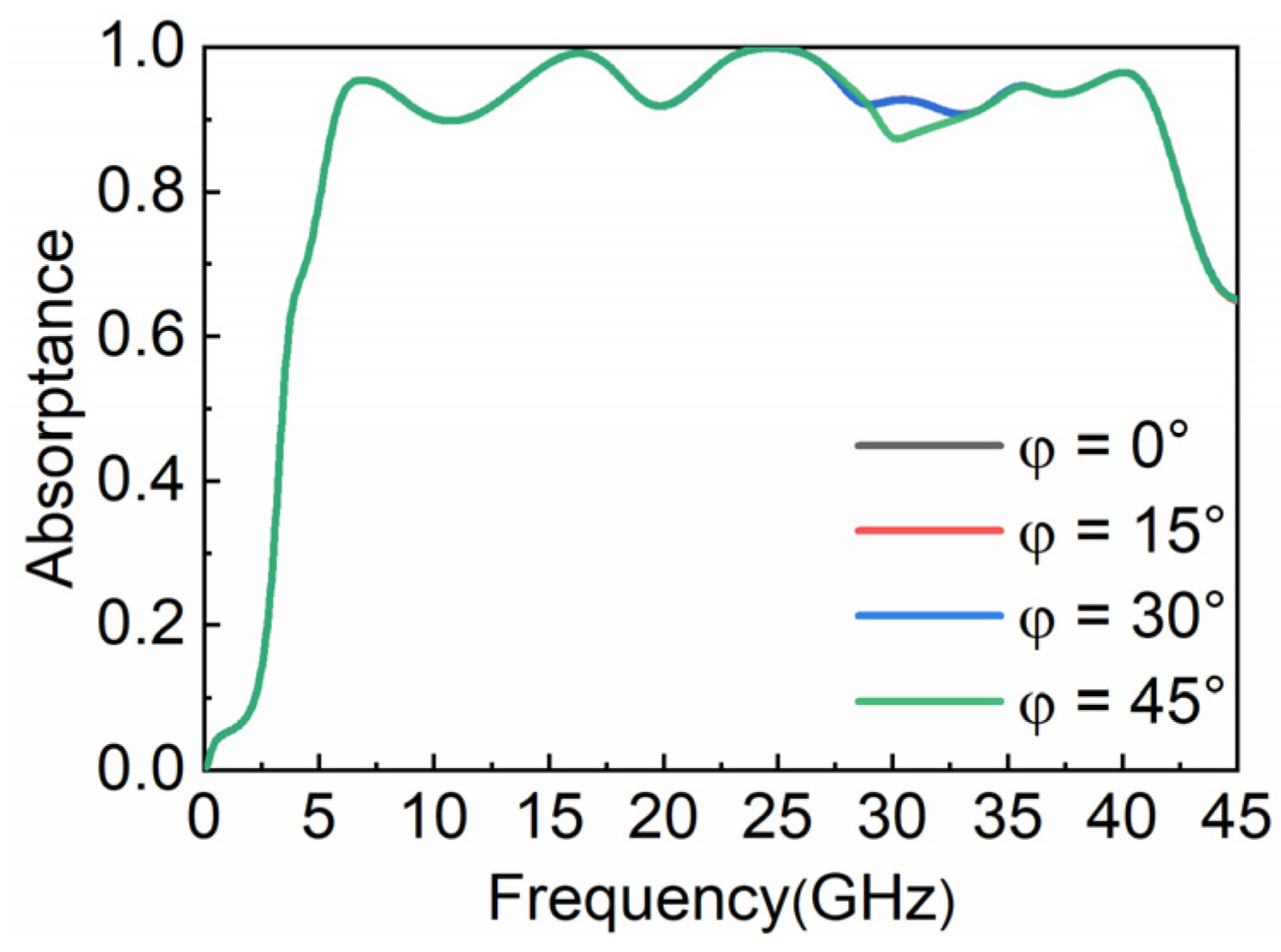
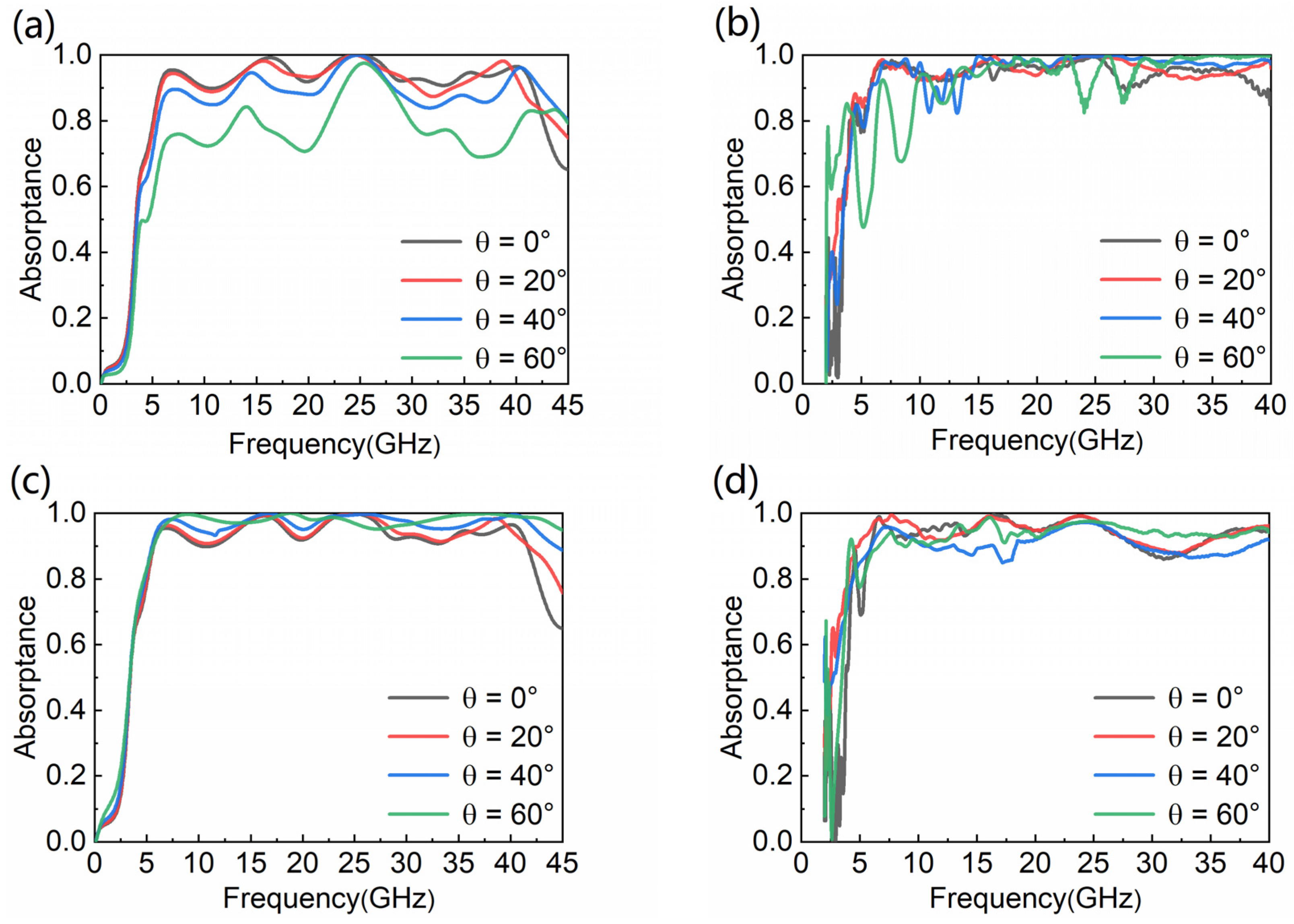



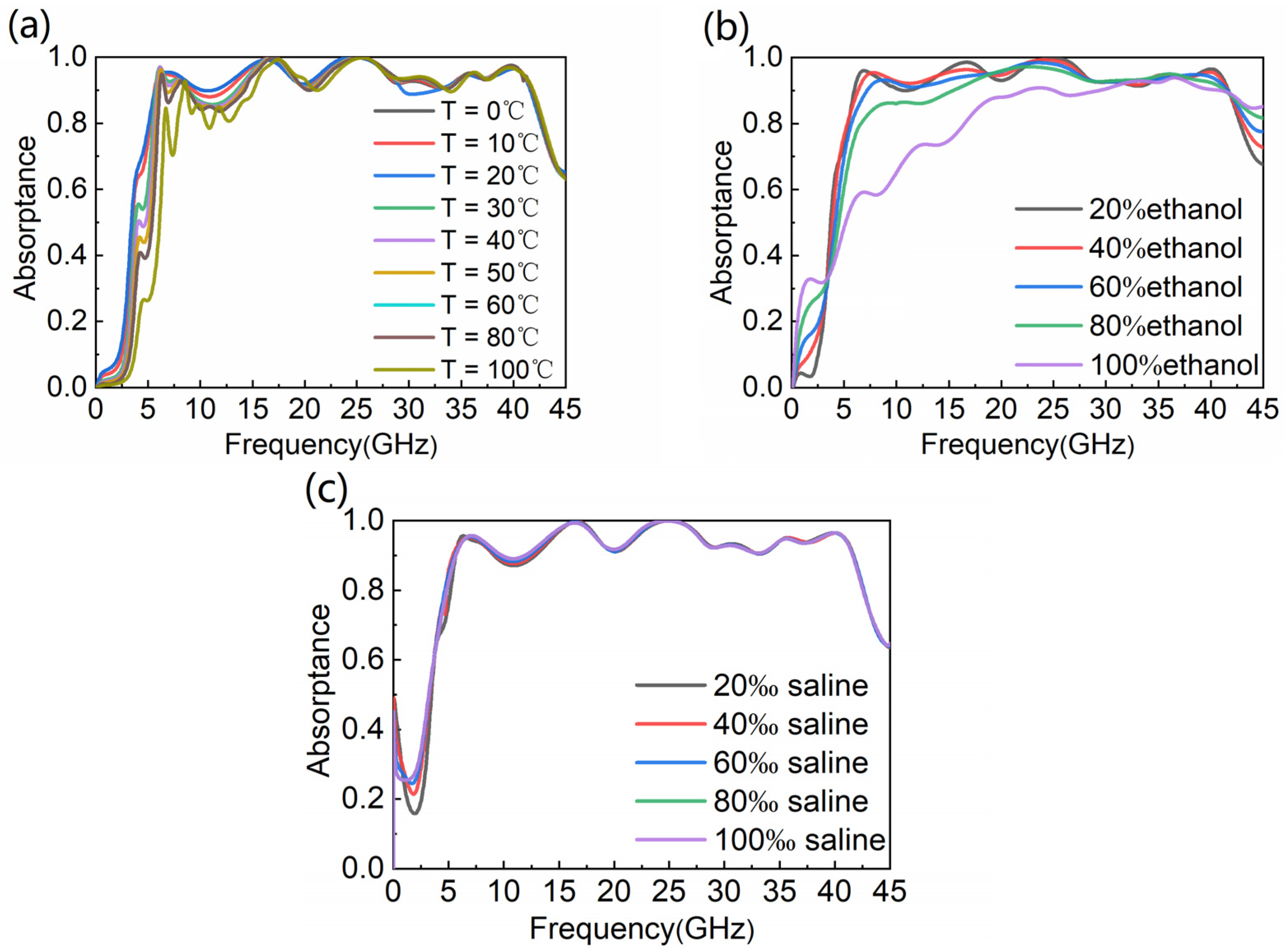



| Parameter | R1 | R2 | R3 | R4 | R5 |
|---|---|---|---|---|---|
| Value (mm) | 1.3 | 2 | 0.35 | 1.25 | 2 |
| Parameter | H1 | H2 | H3 | H4 | H5 |
| Value (mm) | 5.6 | 2 | 2 | 1 | 4 |
| Ref. | RB (%) | BW (GHz) | λl–λh (mm) | Periodicity | Thickness | Uni-/Bi-Directional | Transparent | All- Dielectric |
|---|---|---|---|---|---|---|---|---|
| [38] | 66.7/100 | 7.5–15/5–15 | 40–20/60–20 | 8 mm: 0.2λl–0.4λh /0.13λl–0.4λh | 7 mm: 0.18λl–0.35λh /0.12λl–0.35λh | Uni- | No | No |
| [39] | 114.9 | 6.4–23.7 | 46.9–12.7 | 12.5 mm: 0.27λl–0.98λh | 3.7 mm: 0.08λl–0.29λh | Uni- | Yes | No |
| [40] | 101.1 | 7.74–23.56 | 38.8–12.73 | 10 mm: 0.26λl–0.79λh | 12.8 mm: 0.33λl–1λh | Uni- | No | Yes |
| [41] | 6.9 | 10.45–11.20 | 28.7–26.8 | 12 mm: 0.42λl–0.45λh | 9 mm: 0.31λl–0.34λh | Uni- | Yes | Yes |
| [42] | 118.0 | 7.28–28.22 | 41.2–10.6 | 16 mm: 0.39λl–1.51λh | 6.5 mm: 0.16λl–0.61λh | Uni- | Yes | Yes |
| This work | 151.8 | 5.7–41.6 | 52.6–7.2 | 10 mm: 0.19λl–1.39λh | 13.2 mm: 0.25λl–1.83λh | Bi- | Yes | Yes |
Publisher’s Note: MDPI stays neutral with regard to jurisdictional claims in published maps and institutional affiliations. |
© 2022 by the authors. Licensee MDPI, Basel, Switzerland. This article is an open access article distributed under the terms and conditions of the Creative Commons Attribution (CC BY) license (https://creativecommons.org/licenses/by/4.0/).
Share and Cite
Cao, M.; Huang, X.; Gao, L.; Li, X.; Guo, L.; Yang, H. Broadband Bi-Directional All-Dielectric Transparent Metamaterial Absorber. Nanomaterials 2022, 12, 4124. https://doi.org/10.3390/nano12234124
Cao M, Huang X, Gao L, Li X, Guo L, Yang H. Broadband Bi-Directional All-Dielectric Transparent Metamaterial Absorber. Nanomaterials. 2022; 12(23):4124. https://doi.org/10.3390/nano12234124
Chicago/Turabian StyleCao, Miao, Xiaojun Huang, Lina Gao, Xiaoyan Li, Linyan Guo, and Helin Yang. 2022. "Broadband Bi-Directional All-Dielectric Transparent Metamaterial Absorber" Nanomaterials 12, no. 23: 4124. https://doi.org/10.3390/nano12234124





